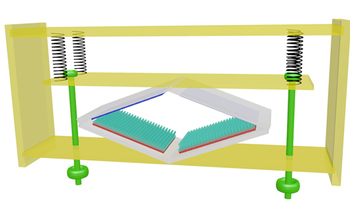Multimedia Gallery
The triboelectric nanogenerator (TENG) harvests energy generated by human walking.
The triboelectric nanogenerator (TENG) is made from thin, lightweight plastic sheets, interlocked in a rhombic grid. As the wearer walks, the rhythmic movement that occurs as his/her weight shifts from side to side causes the inside surfaces of the plastic sheets to touch and then separate, touch and then separate. The periodic contact and separation drives electrons back and forth, producing an alternating electric current.
This process, known as the triboelectrification effect, also underlies static electricity. The key to the new technology is the addition of highly charged nanomaterials that maximize the contact between the two surfaces, pumping up the energy output of the TENG.
Credit: Zhong Lin Wang, Georgia Tech
Images credited to the National Science Foundation, a federal agency, are in the public domain. The images were created by employees of the United States Government as part of their official duties or prepared by contractors as "works for hire" for NSF. You may freely use NSF-credited images and, at your discretion, credit NSF with a "Courtesy: National Science Foundation" notation.
Additional information about general usage can be found in Conditions.
Also Available:
Download the high-resolution JPG version of the image. (92.3 KB)
Use your mouse to right-click (Mac users may need to Ctrl-click) the link above and choose the option that will save the file or target to your computer.
Related story: Walking can recharge the spirit, but what about our phones?



